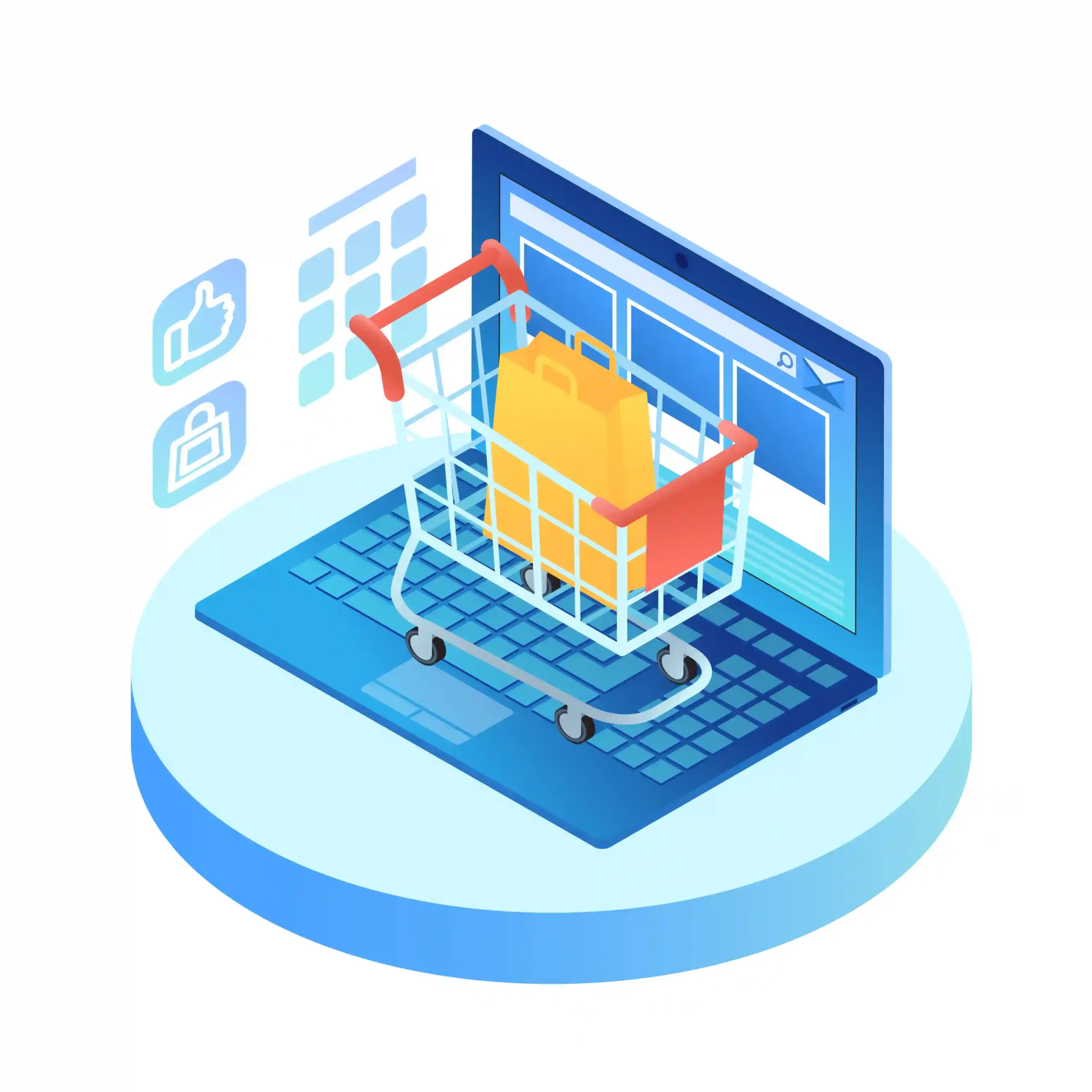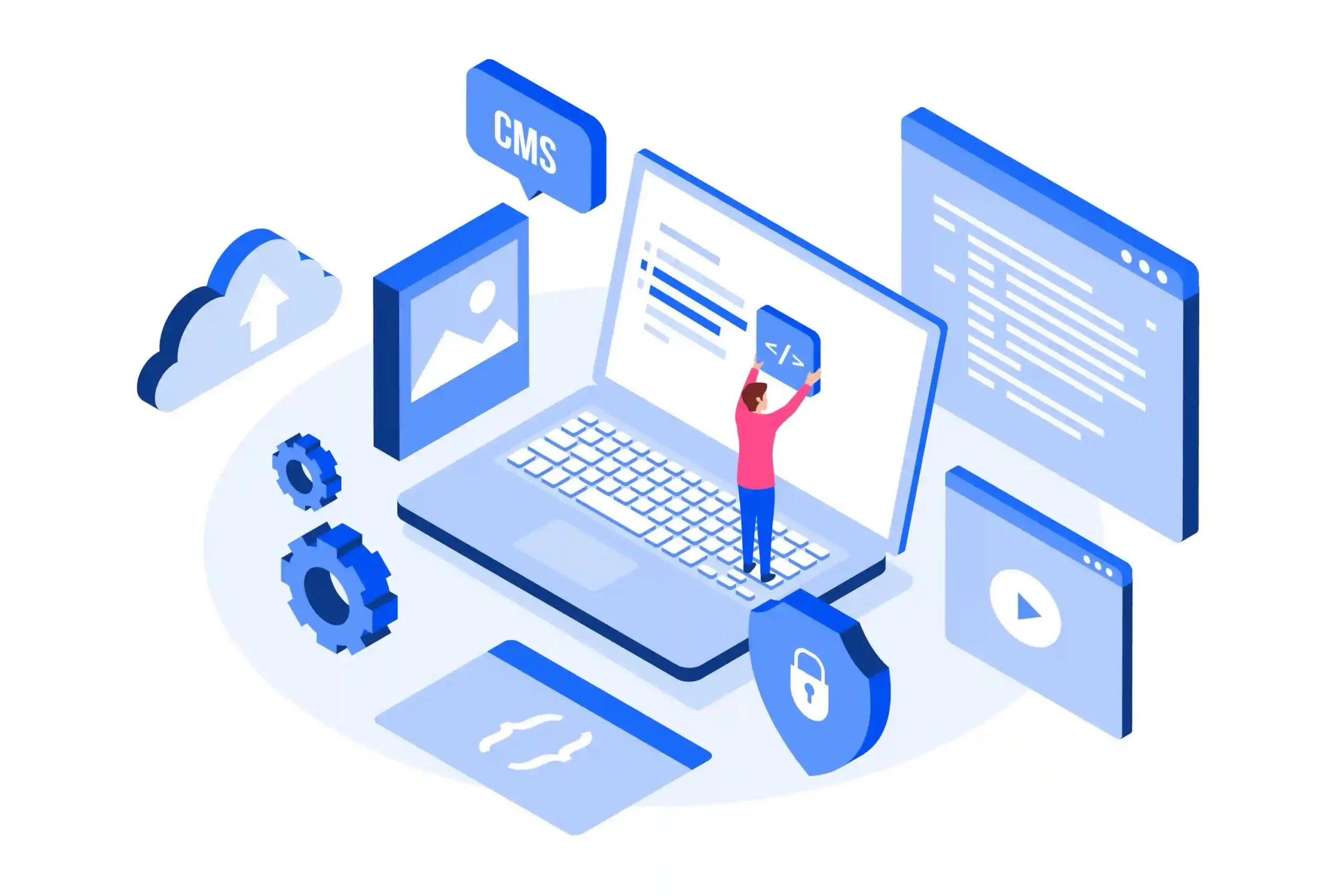Key Takeaways:
- Determine B2B or B2C focus, identify target audience, and craft a unique brand identity.
- Check domain availability, opt for an easy-to-remember URL to enhance brand awareness.
- Select a hosting service with an ecommerce platform, balancing design flexibility and ease of use.
- Communicate business goals through effective website design, ensuring a seamless user experience.
- Thoroughly test the website before launch, addressing any issues to ensure proper functionality.
- Implement key features such as search functionality, product catalog management, secure checkout, payment gateway integration, efficient order management, and user-friendly customer management.
- Consider factors like cost, customization features, SEO capabilities, security, and customer support when selecting an eCommerce Content Management System (CMS).
What is Ecommerce Website Development?
E-commerce website development is the process of creating and building online platforms that enable businesses to sell products or services. It involves designing and developing user-friendly interfaces, integrating secure payment gateways, managing product catalogs, and implementing features to enhance the overall shopping experience for customers. The goal of ecommerce website development is to create a user-friendly and secure platform to sell online. This builds trust with browsers and leads to higher sales and conversions.
The ecommerce website development process involves several steps, including:
- Establishing your brand: This involves making several determinations, such as whether your online business is a business-to-business (B2B) or business-to-consumer (B2C) operation, identifying your target audience, and tailoring your ecommerce project to meet their needs and tastes.
- Buying a domain name: You may want to consider domain name availability when choosing your ecommerce business’s name. An easy-to-remember and eye-catching URL can drive traffic to your ecommerce site and increase brand awareness.
- Choosing a hosting platform: You can choose a website host that offers an ecommerce platform to host your site. Some hosting services offer pre-built website designs optimized for both desktop and mobile viewing.
- Designing your site: Your website design should effectively communicate your business’s goals and be visually appealing. It should also streamline the order process for customers and build brand equity that can carry your business forward.
- Determining how orders will be fulfilled: You should decide how you will fulfill orders, whether through dropshipping, in-house fulfillment, or a third-party logistics provider.
- Building and launching your website: Once you have established your brand, bought a domain name, chosen a hosting platform, designed your site, and determined how orders will be fulfilled, you can build and launch your website.
- Maintaining your site: You should regularly update your website to ensure that it remains secure, user-friendly, and up-to-date with the latest ecommerce trends.
How to develop an Ecommerce Websites

Developing an ecommerce website can be a daunting task, but it doesn’t have to be. Here are some steps to help you get started:
- Establish your brand: Brand establishment in an ecommerce context involves making a number of determinations. First, is your online business a business-to-business (B2B) or business-to-consumer (B2C) operation? You’ll want to determine your target audience and tailor your ecommerce project to meet their needs and tastes, from the style of photography to the level of detail in product descriptions. Finally, you’ll want to come up with a snappy —something memorable and unique that effectively translates your brand’s objectives. when choosing your ecommerce business’s name. is an easy process with Shopify, but in-demand can sometimes go fast—if the domain you want is available, try to get it while you can (you can opt for a short-term contract of a year or two, in case you’re not fully committed). An easy-to-remember and eye-catching URL can drive traffic to your ecommerce site, and increase brand awareness, so you may want to check to see what URLs are available before settling on a company name.
- Buy a domain name: You may also want to consider domain name availability when choosing your ecommerce business’s name. is an easy process with Shopify, but in-demand can sometimes go fast—if the domain you want is available, try to get it while you can (you can opt for a short-term contract of a year or two, in case you’re not fully committed). An easy-to-remember and eye-catching URL can drive traffic to your ecommerce site, and increase brand awareness, so you may want to check to see what URLs are available before settling on a company name.
- Choose a hosting platform: Beyond a memorable logo and eye-catching color palette, your website design should effectively communicate your business’s goals. Some hosting services are barebones—you have to design and build the website yourself—and others offer pre-built website designs optimized for both desktop and mobile viewing. You can choose a hosting platform that suits your needs.
- Design your site: Once you purchase your domain, you can get your website up and running by choosing a website host (preferably one with an ecommerce platform) to host your site as well. Some hosting services are barebones—you have to design and build the website yourself—and others offer pre-built website designs optimized for both desktop and mobile viewing. Beyond a memorable logo and eye-catching color palette, your website design should effectively communicate your business’s goals.
- Determine how orders will be fulfilled: You’ll need to determine how orders will be fulfilled. Will you be shipping products yourself, or will you be using a third-party logistics provider? You’ll also need to determine how you’ll handle returns and exchanges.
- Build and launch your website: Once you’ve completed the above steps, it’s time to build and launch your website. You’ll want to test your website thoroughly before launching it to ensure that everything is working properly.
- Maintain your site: Once your website is up and running, you’ll need to maintain it. This involves updating your product catalog, monitoring your website traffic, and making any necessary changes to your website design.
Custom Ecommerce Website Development
Custom ecommerce website development is the process of creating and building online platforms that enable businesses to sell products or services. It involves designing and developing user-friendly interfaces, integrating secure payment gateways, managing product catalogs, and implementing features to enhance the overall shopping experience for customers. The goal of custom ecommerce website development is to create a user-friendly and secure platform to sell online. This builds trust with browsers and leads to higher sales and conversions.
6 Steps For Developing a Custom Ecommerce Website
- Establish your brand: This step involves creating a unique brand identity that sets you apart from your competitors. You should define your brand’s mission, values, and target audience. This will help you create a brand that resonates with your customers and builds trust.
- Buy a domain name: A domain name is the address of your website on the internet. It should be easy to remember, relevant to your business, and unique. You can purchase a domain name from a domain registrar like GoDaddy or Namecheap.
- Choose a hosting platform: A hosting platform is where your website will be stored and accessed by users. You should choose a hosting platform that is reliable, secure, and scalable. Some popular hosting platforms include AWS, Google Cloud, and Microsoft Azure.
- Design your site: The design of your website should be visually appealing, user-friendly, and optimized for conversions. You can use website builders like Wix or Squarespace to create a professional-looking website without any coding knowledge.
- Determine how orders will be fulfilled: This step involves deciding how you will handle orders, payments, and shipping. You can use third-party services like PayPal or Stripe to process payments and shipping carriers like FedEx or UPS to handle shipping.
- Build and launch your website: Once you have completed the previous steps, it’s time to build and launch your website. You can use a content management system (CMS) like WordPress or Shopify to create your website. Make sure to test your website thoroughly before launching it to the public.
Functionality To Consider When Developing An Ecommerce Website

When developing an ecommerce website, there are several key functionalities to consider. These include:
- Search functionality: This allows customers to search for products by keyword, category, or other criteria. It’s important to ensure that the search function is user-friendly and accurate.
- Product catalog management: This involves managing product information, such as descriptions, images, and pricing. It’s important to ensure that the product catalog is easy to navigate and that products are presented in an appealing way.
- Shopping cart and checkout: This involves designing and implementing a shopping cart and checkout process that is user-friendly and secure. It’s important to ensure that customers can easily add items to their cart, view their cart, and complete the checkout process.
- Payment gateway integration: This involves integrating a payment gateway into your ecommerce website to enable secure online payments. It’s important to ensure that the payment gateway is reliable and secure.
- Order management: This involves managing orders, including order processing, shipping, and tracking. It’s important to ensure that the order management system is efficient and accurate.
- Customer management: This involves managing customer information, such as contact details and order history. It’s important to ensure that the customer management system is user-friendly and secure.
B2C Ecommerce Development
Business-to-consumer (B2C) ecommerce development involves creating and building online platforms that enable businesses to sell products or services directly to consumers. It involves designing and developing user-friendly interfaces, integrating secure payment gateways, managing product catalogs, and implementing features to enhance the overall shopping experience for customers. The goal of B2C ecommerce development is to create a user-friendly and secure platform to sell online. This builds trust with browsers and leads to higher sales and conversions.
Choosing The Right Ecommerce CMS

An eCommerce content management system (CMS) is there to help your online venture be smooth sailing. You only need to choose the model that best suits your business needs. With so many options in the digital landscape, it’s crucial to dig into the matter before making a decision. Factors like cost, customisation features, SEO capabilities, security, and customer support play a vital role in arriving at a decision.
Understanding E-commerce CMS
E-commerce CMS serves as the backbone of an online store, streamlining tasks like product display, stock management, and order processing. Think of it as a LEGO kit, assembling elements to build web pages without coding expertise.
Types of CMS
Choose between open-source CMS (e.g., WooCommerce, Magento) for customisation and control, or SaaS CMS (e.g., Shopify, BigCommerce) for user-friendliness and hassle-free maintenance with a subscription fee.
Ease of Use
Consider the trade-off between user-friendliness and customisation functions. A user-friendly platform may have limitations in customisation and scalability.
Core Functionality
Evaluate the essential features and capabilities of an eCommerce CMS, ensuring they align with your business requirements and support future growth.
Rules and Permissions
Look for a CMS that allows multiple user roles for different tasks, essential as your eCommerce business expands.
SEO-friendliness
Choose a CMS that is SEO-friendly, with features like meta tags, sitemaps, and URL structure.
Security
Choose a CMS that has robust security features, including SSL certificates, firewalls, and regular updates.
Customer Support
Choose a CMS that offers reliable customer support, with multiple channels of communication and quick response times.
How Crongenix Can Transform Your Business with Expert E-commerce Website Development?
Crongenix is your go-to partner for comprehensive e-commerce website development, providing tailored solutions to elevate your online presence. From strategically establishing your brand identity, securing a memorable domain name, and selecting an optimized hosting platform, we guide you through the entire process. Our expertise extends to custom e-commerce website development, ensuring user-friendly interfaces, seamless payment gateways, and efficient functionalities like search, product catalog management, and order fulfillment. With a focus on B2C e-commerce development, we enhance the overall shopping experience, fostering trust with consumers and boosting sales.
Additionally, Crongenix assists in choosing the right eCommerce CMS, considering factors such as cost, customization, SEO capabilities, security, and reliable customer support. Let Crongenix be your partner in creating a secure, user-friendly, and visually appealing online platform that aligns with your business goals, ultimately driving success in the competitive e-commerce landscape.
FAQ’s about Ecommerce Website Development
1) What services does Crongenix offer in e-commerce website development?
Crongenix provides comprehensive e-commerce website development services, including brand establishment, domain name selection, hosting platform guidance, custom website development, and expertise in B2C e-commerce development. We focus on creating user-friendly interfaces, seamless payment gateways, and efficient functionalities for a successful online presence.
2) How does Crongenix assist in choosing the right eCommerce CMS for my business?
Crongenix guides you in selecting the most suitable eCommerce Content Management System (CMS) by considering factors like cost, customization features, SEO capabilities, security, and reliable customer support. We ensure your online store’s smooth functioning with a CMS that aligns with your business goals.
3) What sets Crongenix apart in custom e-commerce website development?
Crongenix specializes in custom e-commerce website development, aiming to create secure, user-friendly platforms that build trust with consumers and lead to higher sales. We focus on designing interfaces, integrating secure payment gateways, and implementing features to enhance the overall shopping experience.
4) How does Crongenix approach the maintenance of e-commerce websites?
Crongenix emphasizes regular updates to ensure your website remains secure, user-friendly, and aligned with the latest e-commerce trends. We handle tasks such as product catalog updates, website traffic monitoring, and necessary changes to your website design to maintain optimal performance.
5) Can Crongenix help with B2C e-commerce development to enhance the shopping experience?
Yes, Crongenix specializes in Business-to-Consumer (B2C) e-commerce development, focusing on creating user-friendly interfaces, integrating secure payment gateways, and managing product catalogs. Our goal is to enhance the overall shopping experience, fostering trust with consumers and boosting sales.
